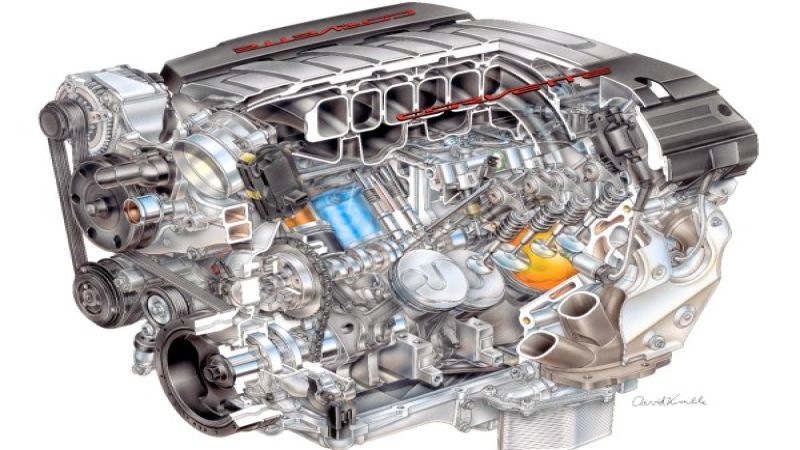In recent General Motors history, the Chevrolet Corvette has introduced a collection of V8 engines that spent a short amount of time exclusively in the Corvette before being offered as the “base V8” in the Chevrolet Camaro. The LS1 and LS3 engines were both introduced in the Chevrolet Corvette before becoming the chosen engine for the Camaro SS – both of which offered slightly less power in the Camaro than they did in the Corvette. That is almost guaranteed to be the case with the new LT1 that was introduced in the 2014 Chevrolet Corvette Stingray with 455 horsepower (460hp with the performance exhaust package) so when the 6th generation Chevrolet Camaro is introduced for the 2016 model year, the SS model will almost surely pack the same LT1 as the Stingray.
Should that be the case, the 2016 Chevrolet Camaro SS will likely offer somewhere around 450 horsepower and 450lb-ft of torque. That is a pretty significant increase from the 426 horsepower and 420lb-ft of torque offered by the LS3 V8 in the current Camaro SS while still leaving a small gap in power figures between itself and the Stingray. More importantly, a 6th generation Camaro with 450hp and 450tq will likely have a big advantage over the Ford Mustang. Ford Motor Company hasn’t announced official figures for the new 2015 Mustang GT but with a promise of “more than 420hp”, we wouldn’t expect more than 430 horsepower from the 5.0L V8 when the numbers become official. I believe that the 2015 Mustang GT will be rated at 430 horsepower and 400lb-ft of torque which serve as an increase of 10hp and 10lb-ft of torque compared to the current Mustang GT. Although the new Mustang is lighter than the current model (thus offering a better power to weight ratio), a 2016 Camaro SS with 450 horsepower and 450lb-ft of torque could steal some sales from a Mustang with 430hp and 400lb-ft of torque simply based on the fact that it has bigger numbers. The tightly contested muscle car race is one of inches and being able to boast of having 20 more horsepower and a whopping 50 more lb-ft of torque will almost certainly steal some buyers from the Mustang camp.
Even if General Motors waters down the new LT1 a bit more to leave a bigger performance gap between the new Corvette Stingray and the 6th generation Camaro to levels like 440 horsepower and 440lb-ft of torque – there will likely be a big enough torque difference between the two Detroit muscle cars to give the Camaro a big advantage in the eyes of prospective buyers.
While the introduction of the new LT1 to the 2016 Chevrolet Camaro seems little more than common sense, I wouldn’t expect that to be the only change for the next generation GM muscle car. In addition to some aesthetic changes, I would be shocked if GM didn’t find a way to cut weight from the Camaro as that will improve performance and fuel economy capabilities so even though the 2015 Mustang should be lighter than the current models – the Camaro will likely undergo a similar weight loss program to keep that portion of the playing field level.
Should my beliefs prove to be true with an LT1 V8 with 450 horsepower and 450lb-ft of torque fitted under the hood of a lighter 2016 Chevrolet Camaro, Ford will have no choice but to pack the Mustang GT with more power to keep up. Even if the less powerful Mustang is somehow quicker than the 6th generation Camaro SS, the bigger power numbers from the Camaro camp will help to bolster their strong sales and in the end – the automakers are more worried about selling cars than they are whose cars are faster.












Comments
The performance still does
Permalink
The performance still does not match the performance that I get from my model T.
The 2014 GT500 has 660hp and
Permalink
The 2014 GT500 has 660hp and 640 foot pounds of torque. No one from ford has hinted at GT500 model for the redesign in 2015, but I would imagine ford isn't going to be giving up that 200 HP/torque advantage if Camaro comes out with that great new V8 in 2016. The only 4 engines they talked about in 2015 are the Base V6, the Ecoboost V6, the Ecoboost i4 and the 5.0 V8, so no mention of a higher end model ahead of the GT ford usually has...furthermore, Ford Also said the '15 GT outperformed a '13 boss 302, which was also superior in HP and torque, so It will be interesting like you said to see what numbers they release.
Wow how this report turned
Permalink
Wow how this report turned out to be WRONG on many levels:
1) The 2015 Mustangs, all weight 200 lbs more than before therefore negating the small performance increases.
2) The only news worthy to report is the IRS. The 4 cylinder turbo increased torque over the V6 is lost due to the weight gain as well so expect similar performance. MPGs will be about the same in the real world.
3) The new Cadillac-based-ATS-platform Camaro will DROP 300 to 400 lbs of weight from the current Camaro, as reported by car and driver. Go ahead and check the weight of the ATS. So even if they keep the same HP/TQ figures, the new Camaro will have better power to weight ratio.
What I used to criticize Chevy for will now be my bone to pick with Ford. BTW, most manufacturers are going to heavier weight.